

The Ospedale di Santa Maria della Misericordia has its own page in this website.
The hospices that belonged to two of the confraternities of Perugia are mentioned in the pages on their respective oratories:
-
✴the Oratorio di Sant’ Agostino; and
However, the Ospedale dei Pellegrini, which belonged to the Confraternita di San Domenico, is described on this page because it was near but not adjacent to the brothers’ oratory.
Walk IV
Conservatorio delle Derelitte (1704)
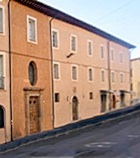
The orphanage was originally administered by the Confraternita di San Tommaso d' Aquino, but Bishop Napoleone Comitoli transferred it to the care of the Barnabites in 1622. It moved to this site in Borgo XX Guigno in 1704, to premises donated by Prospero Podiani . (Its original premises were incorporated into the nunnery of Santa Maria Maddalena delle Repentute).
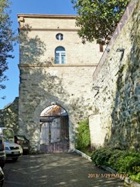
The ancient church of San Prospero was documented as a possession of the Opere Pie Donini in 1905.
Oratorio di Sant’ Anna
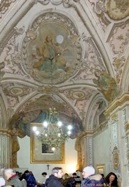
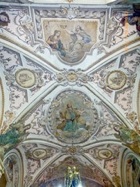
The complex of the Conservatorio delle Derelitte included this oratory (43 Borgo XX Guigno, behind the ochre facade to the left in the photograph above). The oratory is now in secular use. The remnants of a rose window over its portal survive.
Frescoes (1752)
These distinctive frescoes by Paolo Brizi cover the ceiling and walls of the Oratorio di Sant’ Anna. The scenes in tondi depict:
-
✴St Anne in glory;
-
✴the Coronation of the Virgin; and
-
✴allegories of virtues.
Ospedale di San Giacomo (1394)
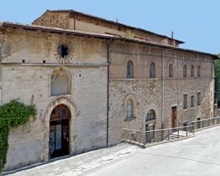
The Commune built this hospice for pilgrims travelling between Perugia and Assisi and/or Rome. A small parish church that had stood near the eastern arch of the nearby Due Porte (subsequently in the inner face of Porta San Pietro) from at least 1285 was annexed to the hospice as its chapel (the Cappella di San Giacomo) in ca. 1400, at which point the complex passed to the Collegio del Cambio. Their arms (a griffin on a box) are on the facade at number 8.
Sodalizio di San Martino (1574)
The Servite Damiano Bissi formed what was originally the Compagnia di San Martino in 1574 in order to provide various forms of assistance (mostly medical) to the poor. It sustained itself by operating a large organic farm and a pharmacy. More details are given in the website of the Sodalizio di San Martino.
The society’s headquarters were originally in Porta Sant’ Angelo.
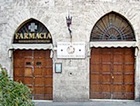
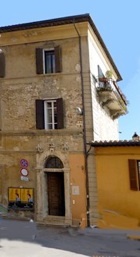
Ospedale dei Pellegrini (1333)
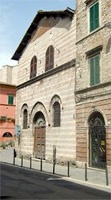
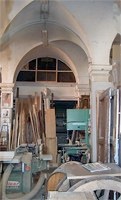
This hospice, with its elegant pink and white façade, is the best-preserved of the medieval hospices of Perugia. The Confraternita di San Domenico established it as a place where pilgrims visiting Perugia could stop for free bread and wine. These pilgrims often arrived for the feast that celebrated the discovery in Jerusalem of the relics of St Stephen (3rd August), when the benefits of a plenary indulgence were available at the Dominicans' nearby church of Santo Stefano del Castellare. Most of these pilgrims would have come from Assisi, where the Portiuncula Indulgence was available on August 1st and 2nd.
The hospice, which operated until the late 19th century, now houses a carpenter’s workshop.
Walk V
Santa Maria Annunziata (14th century)
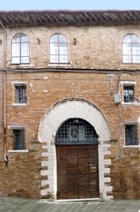
The hospice became known as the Cappuccinelli from 1539, when Bernardino Ochino established a seminary here for 20 male orphans and other poor boys aged from 8 to 20, who were cared for and educated at the expense of the Collegio dei Notai.
The boys from orphanage and those from Santa Maria degli Angeli moved to Santa Maria delle Orfane delle Cappuccinelle in the early 19th century, and the orphanage for girls that existed there moved to Santa Maria degli Angeli.
Annunciation with St Luke (ca. 1450)
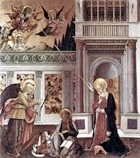
The co-patrons of the guild were the Virgin Annunciate and St Luke, and this determined the subject of the altarpiece. The Annunciation is set in a Renaissance palace, presumably intended to represent the Virgin’s home. God the Father in a mandorla of seraphim appears against a golden sky above a rocky landscape, surrounded by flying angels, and sends the Holy Spirit towards the Virgin in the form of a dove. St Luke (with the ox that is his usual attribute) squats between the Virgin and the angel Gabriel and records the miracle for his Gospel, as a good notary would. The original predella, which depicted the Pietà with SS Mark and Jerome, still survived in 1822 but was subsequently lost.
Annunciation (1525-8)
This altarpiece, which is signed by Sinibaldo Ibi and dated 1528, was commissioned by the procurators of the hospice and was destined for its chapel. On receipt of the altarpiece, the procurators commissioned its frame from Giovanni Battista Bastoni, to a design by Sinibaldo Ibi.
The altarpiece was subsequently moved to the Collegio dei Notai, probably in 1588 before that building was partly demolished, changing places with another altarpiece of the same subject that is attributed to Benedetto Bonfigli (above). The altarpiece by Sinibaldo Ibi seems to have returned to its original location in the early 19th century, and entered the Galleria Nazionale in 1863. Its original frame no longer survives.
Sant' Egidio (1321)
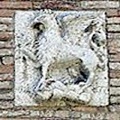
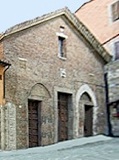
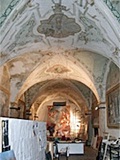
This complex belonged to the Collegio della Mercanzia, whose arms (a griffin on bales of cloth) can be seen on its facade. An inscription inside records its original construction in the time of its first prior, Andreuccio di Stefano in the time of Pope John XXII (1316-34).
The inscription above a portal of the hospice (number 84) refers to it as a “domus pauperum”(home of the poor) and records its restoration in 1507.
The church, which was restored in 1793, is now used as an artist's workshop (illustrated above).
Madonna della Misericordia (1476)
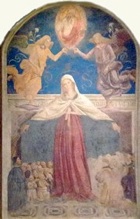
The fresco depicts the Virgin sheltering members of the Collegio della Mercanzia (who owned the hospice) and inmates from the hospice under her cloak. The large figure to the left is probably Canon Galeotti. God the Father looks down as two angels appear to crown the Virgin: it is likely that they originally held a golden crown that has been lost.
Walk VI
San Crispino (1340)
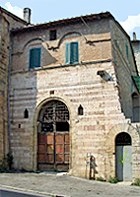
Walk VII
San Nicolò degli Incurabili (1585)
This hospital belonged to the hospitaller Order of St John of God. They financed their operations largely by voluntary donations, and were known colloquially as the Fatebenefratelli from their plea for alms from passers-by: “fate bene fratelli” (do good brothers). [St John of God, who died in 1550, was canonised in 1690.]
Bishop Vincenzo Ercolani called the Fatebenefratelli to Perugia in 1584 and the hospital that they established in the city was their second (after their initial foundation in Rome). The first Perugian hospital was in Via della Conca, but the present larger hospital opened with a procession of the brothers and their first patients in January 1585. Pope Gregory XIII granted indulgences on this occasion, to attract donations. The hospital became known as the Ospedale degli Incurabili because it specialised for a period in the treatment (such as it was) of syphilis.
The hospital passed to the Congregazione della Carità in 1861. It was extended and restored in 1864 and again in 1905. It remained in use as a hospital until 1996.

San Giovanni di Dio (1584)
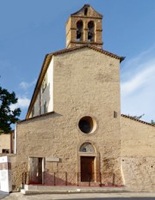
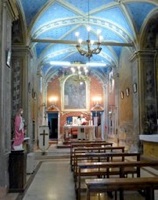
The Fatebenefratelli built this church, which was dedicated to their founder, soon after their arrival in Perugia. Pietro Soriano, the first Minister General of the Order, was buried here in 1588. The church acquired a dedication to St Nicholas in 1628, when the parish of San Nicolò was suppressed, although it is usually known by its original name.

Virgin and Saints (ca. 1700)
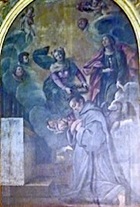
Read more:
J. Nemec, “I Fatebenefratelli a Perugia”, (1984) Rome
Return to Monuments of Perugia.
Return to Walk VII.

